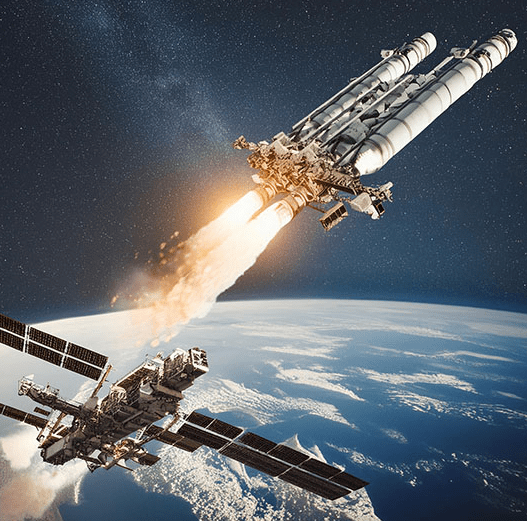NASA has given Elon Musk’s SpaceX the contract to ‘deorbit’ (and destroy) the International Space Station at the end of its operation as NASA transitions to commercially owned space destinations closer to home.

SpaceX To Develop The Deorbit Vehicle
US space agency NASA has chosen SpaceX to develop and deliver the U.S. Deorbit Vehicle that NASA says will “ensure a safe and responsible transition in low Earth orbit at the end of station operations”, i.e. it will tow the space station into low earth orbit before it burns up on re-entry. NASA reports that while SpaceX will develop the deorbit spacecraft, NASA will take ownership after development and operate it throughout its mission. NASA also says that along with the space station, SpaceX’s Deorbit Vehicle “is expected to destructively breakup as part of the re-entry process.”
When?
The International Space Station has been in operation since 1998 and NASA says the United States, Japan, Canada, and the participating countries of ESA have committed to operating the station through 2030.
How Much?
The contract for SpaceX to make the Deorbit Vehicle is thought be worth $843 million.
Whose Responsibility?
Although SpaceX is to make the Deorbit Vehicle, NASA says the safe deorbit of the International Space Station is the responsibility of all five space agencies – CSA (Canadian Space Agency), ESA (European Space Agency), JAXA (Japan Aerospace Exploration Agency), NASA (National Aeronautics and Space Administration), and Russian State Space Corporation Roscosmos.
Where Will It Land?
It is expected that any parts of the space station and Deorbit Vehicle that don’t fully break up on re-entry will land in the ocean with NASA saying the actions of the Deorbit Vehicle will “ensure avoidance of risk to populated areas.”
What If It Hits Your House?
Although NASA’s plans sound good, try telling that to a Florida family who are currently suing NASA after a 1.6lb (725g), 4ins by 1.6ins part from the International Space Station crashed through their roof and floor. Thankfully, none of the family, who are seeking $80,000 (£63,000) for the stress and impact on their lives, were physically injured. According to NASA, the metal part that hit their home was the result of ground controllers using a robotic arm on the space station to release an almost 3-ton cargo pallet containing “aging batteries” back in March 2021.
Mica Nguyen Worthy, the lawyer for the Oteros family, has been quoted as saying: “Here, the U.S. government, through NASA, has an opportunity to set the standard or ‘set a precedent’ as to what responsible, safe, and sustainable space operations ought to look like. If NASA were to take the position that the Oteros’ claims should be paid in full, it would send a strong signal to both other governments and private industries that such victims should be compensated regardless of fault”.
Space Debris
Space debris has become a significant problem due to the increasing number of satellites and space missions, leading to a crowded orbital environment. For example, it’s estimated that there are approximately 36,500 pieces of space debris larger than 10 centimetres, about 1 million pieces between 1 and 10 centimetres, and around 130 million pieces smaller than 1 centimetre currently orbiting Earth.
This debris poses risks to active satellites, spacecraft, and indeed, the International Space Station, potentially causing collisions and generating more debris in a dangerous feedback loop known as the ‘Kessler Syndrome’. With this danger in mind, the ‘Space Liability Convention’ of 1972 was created to establish the liability of countries for damage caused by their space objects.
What Does This Mean For Your Business?
The decision by NASA to entrust SpaceX with the task of deorbiting the International Space Station (ISS) heralds a new era in commercial space operations, signalling some perhaps significant implications for businesses. As the ISS’s operations transition to commercially owned space destinations, companies in the aerospace sector are poised to gain unprecedented opportunities. SpaceX’s $843 million contract not only highlights the increasing role of private entities in space but also the potential for lucrative government contracts and partnerships in an evolving space economy.
For businesses, this shift could mean an expanding market for innovation in space technologies. Companies involved in developing deorbiting vehicles, space debris mitigation, and sustainable space operations may expect increased demand for their expertise. The collaborative approach required by the five space agencies overseeing the ISS deorbiting operation also suggests a growing need for international cooperation and compliance with space liability conventions, making regulatory and legal expertise in space law more valuable than ever.
Also, the challenges highlighted by incidents such as the Oteros family’s lawsuit against NASA underline the importance of risk management strategies. The outcome of this lawsuit could, for example, set a significant legal precedent for how liabilities from space debris impacts are handled, potentially influencing policies and compensation frameworks globally. Businesses need to be prepared for potential liabilities associated with space operations, including debris impact on Earth, and adapt their operations to mitigate such risks effectively.
This scenario presents an opportunity for businesses to develop advanced tracking, monitoring, and risk mitigation solutions to ensure the safety and sustainability of space activities. The case also demonstrates the need for companies to engage in proactive legal and insurance planning to manage potential claims and safeguard their operations.
In essence, the move to commercialise space destinations and manage space debris responsibly potentially opens many of avenues for businesses to innovate and expand. Staying ahead in this competitive landscape will require agility, a commitment to sustainability, and an understanding of the complex regulatory environment governing space operations. As space becomes a more integral part of our economic infrastructure, businesses that can perhaps seize new opportunities position themselves as significant players in the growing space industry.
Finally, on the subject of space, it’s also worth noting here that NASA’s plans to return to the Moon, through the Artemis program, may also bring commercial opportunities. For example, the lunar missions will require new technologies, habitats, and supply chains, presenting another vast market for companies involved in space exploration and infrastructure. A move to greater lunar exploration will undoubtedly bring a need for innovative solutions and partnerships to support sustainable operations, e.g. on the Moon and beyond.
By Mike Knight
